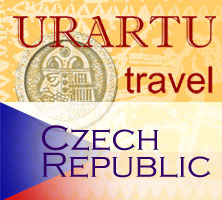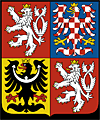About Czech Republic
General Information -- Geography -- Climate -- Religion -- Language -- Population and Ethnic Composition-- Government -- Administrative Division -- Time Zone -- Currency Exchange and Credit Cards -- Capital City -- Official Holidays -- Airports and Public Transportation -- Traditional Cuisine -- Brief History
General Information
The Czech Republic is a country of fairytale castles, forests and fishponds, medieval towns and Renaissance chateaux. There is a rich heritage to explore – unravel Czech history and you’ll get a deeper understanding of Europe as a whole – with the added bonus j of the world’s finest beer to lubricate debate. And at the centre of it all lies Prague, one of the most beautiful and cultured cities in the world.
No matter which direction you travel across Europe, you’ll pass through the Czech Republic at some point. Landlocked in the heart of the continent, it has been fought over and occupied by its bigger neighbours for most of its history and only emerged as a separate country in 1993. When it joined the EU in 2004, Czech celebrated their return to the centre of a united Europe.
Geography
The Czech landscape is quite varied; Bohemia to the west consists of a basin, drained by the Elbe and Vltava Rivers, surrounded by mostly low mountains such as the Sudeten with its part Krkonoše, where one also finds the highest point in the country, the Sněžka at 1,602 metres. Moravia, the eastern part, is also quite hilly and is drained predominantly by the Morava river, but also contains the source of the Oder river. Water from the landlocked Czech Republic flows to three different seas: the North Sea, Baltic Sea and Black Sea.
Climate
The local climate is temperate with warm summers and cold, cloudy, humid winters, typified by a mixture of maritime and continental influences.
Religion
Major religions in the Czech Republic are: Roman Catholic (26.7%), Evangelical Church of Czech Brethren (1.1%), Czechoslovak Hussite Church (1.0%), Jehovah's Witnesses (0.22%), Czech and Slovak Orthodox Church (0.22%), other (2.8%). 58.9% is nonreligious, 8.8% are undecided.
Language
Czech language, in the past sometimes also called Bohemian, member of the West Slavic group of the Slavic subfamily of the Indo-European family of languages, is the official language of the Czech Republic. It is spoken by about 11 million people, of whom over 10 million reside there and close to 1 million of whom are in Slovakia and North America combined.
Population and Ethnic Composition
The Czech Republic is fairly homogeneous; 95% of the population are Czech and 3% are Slovak. There is a significant Roma population (0.3%), and Poles.
Government
According to its constitution the Czech Republic is a parliamentary democracy, whose head of state is a president, indirectly elected every five years by the parliament. The president is also granted specific powers such as the right to nominate Constitutional Court judges, dissolve parliament under certain conditions, and enact a veto on legislation. He also appoints the prime minister, who sets the agenda for most foreign and domestic policy, as well the other members of the cabinet on a proposal by the prime minister. The Czech parliament is bicameral, with a Chamber of Deputies and a Senate . The 200 Chamber delegates are elected for 4-year terms, on the basis of proportional representation. The 81 members of the Czech Senate serve for 6-year terms with one-third being elected every 2 years on the basis of two-round majority voting. The country's highest court of appeals is the Supreme Court. The Constitutional Court, which rules on constitutional issues, is appointed by the president, and its members serve 10-year terms.
Administrative Division
The Czech Republic consists of 14 regions (kraje) and the capital city Prague (Praha).
Time Zone
Czech Republic in the Central European Time Zone. Central European Standard Time(CET) is 1 hours ahead of Greenwich Mean Time(GMT+1).Summer (Daylight-Saving) Time is observed in Czech Republic, where the time is shifted forward by 1 hour; 2 hours ahead of Greenwich Mean Time (GMT+2).
After the Summer months the time in Czech Republic is shifted back by 1 hour to Central European Time (CET) or (GMT+1)
Currency Exchange and Credit Cards
The Czech crown (Koruna ceska, or Kc, or CZK) is divided into 100 hellers (haleru, or h). Banknotes come in denominations of 20, 50, 100, 200, 500, 1000, 2000 and 5000KC; coins are of 10, 20 and 50h and one, two, five, 10, 20, and 50Kc. The current (June 2006) exchange rate was 1 EUR = 28.5267 CZK; 1 USD = 22.5684 CZK.
There is a good network of ATMs throughout the country. The main banks are the best places to change cash and travelers cheques or get a cash advance on Visa or MasterCard.
Credit cards are widely accepted in petrol stations, mid-range and top-end hotels, restaurants and shops.
Capital City
Prague is the capital and largest city of the Czech Republic. Situated on the Vltava river in central Bohemia, it is home to approximately 1.2 million people.
The city centre is a smorgasbord of stunning architecture, from Gothic, Renaissance and Baroque to neoclassical, Art Nouveau and Cubist. There’s a maze of medieval lanes to explore, riverside parks for picnics, lively bars and beer gardens, jazz clubs, rock venues, museums and art galleries galore.
Official Holidays
- January - New Year’s Day
- March/April - Easter
- 1 May - Labour Day
- 8 May - Liberation Day
- 5 July - SS Cyril and Methodius Day
- 6 July - Jan Hus Day
- 28 September - Czech Statehood Day
- 28 October - Republic Day
- 17 November - Struggle for Freedom and Democracy Day
- 24-26 December - Christmas
Airports and Public Transportation
The national carrier, Czech Airlines, has direct flights to Prague from many European cities, the Middle East and North America.
Prague’s main international bus station is Uan Praha Florenc, 600 m north of the main train station. The peak season for bus travel is from mid-June to the end of September, when there are daily buses to major European cities; outside this season, frequency falls to two or three a week.
International trains arrive at Prague’s main trainstation, or the outlying Holesovice and Smichov stations.
Within the Czech Republic, buses are often faster, cheaper and more convenient than the train. Many bus routes have reduced frequency at weekends. Bus ticketing at main stations is computerized, so you can often book ahead and be sure of a comfortable trip.
City buses and trams operate from around 4:30am to midnight daily. Tickets must be purchased in advance – they are sold at bus and train stations, newsstands and vending machines – and must be validated in the time-stamping machines found on buses and trams and at the entrance to metro stations.
Taxis have meters – just make sure they’re switched on.
Czech Republic provides efficient train services to almost every part of the country. Fares are based on distance.
Traditional Cuisine
Traditional Czech cuisine is strong on meat, dumplings and gravy, and weak on fresh vegetables – the classic Bohemian dish is knedlo-zelo-vepro – bread dumplings, sauerkraut and roast pork. Other tasty home-grown delicacies to look out for include cesnekova (garlic soup), svickova na smetane (roast beef with sour cream sauce and cranberries) and karp na kmini (fried or baked carp with caraway seed).
Prague is a beer drinker’s paradise. Bohemian beer is probably the best in the world – the most famous brands are Budvar and Plzensky Prazdroj (Pilsner Urquell), and Prague’s own Staropramen.
Brief History
The Good King Wenceslas of Christmas carol fame was actually a prince, and the land he looked out over was Bohemia. This region, along with neighboring Moravia, makes up the territory of the modern Czech republic. Beautified as St Wenceslas, he remains the country’s patron saint.
Their location in the heart of Europe has seen the tides of war and imperial domination wash back and forth over Bohemian and Moravia for centuries. Many events on Czech history have had repercussions throughout the continent, from the hurling of two Habsburg councilors from a Prague castle window in 1618 (the famous Defenestration of Prague), which sparked of the Thirty Years war, to Hitler’s annexation of Sudetenland (the western borderlands of Czechoslovakia) in 1938, the event which triggered the final slide towards WWII.
The two “Golden Ages” of Czech history were the rule of Charles IV (1346-78), who founded Prague’s St Vitus Cathedral, built Charles Bridge and established Charles University; and the reign of Rudolf II (1576-1612), who made Prague the capital of the Habsburg Empire and drew many great artists, scholars and scientists to his court. Bohemia and Moravia remained under Habsburg dominion for the best part of 400 years.
The 20th century was notable for the “years of eight”. Czechoslovakia was created after the fall of the Habsburg Empire on 1918, was occupied by the Nazis in 1938, and fell to a communist coup in 1948. And the hopeful “Prague Spring”, when censorship was relaxed and political prisoners were released, was crushed by the Soviet invasion of 1968.
The Velvet Revolution – the bloodless overthrow of the communist regime – however, didn’t happen until 1989. It was soon followed by the Velvet Divorce of 1993, when Czechoslovakia split into separate Czech and Slovak republics, the former led by famous playwright and former political prisoner Vaclav Havel, whose term in office lasted until 2003.



